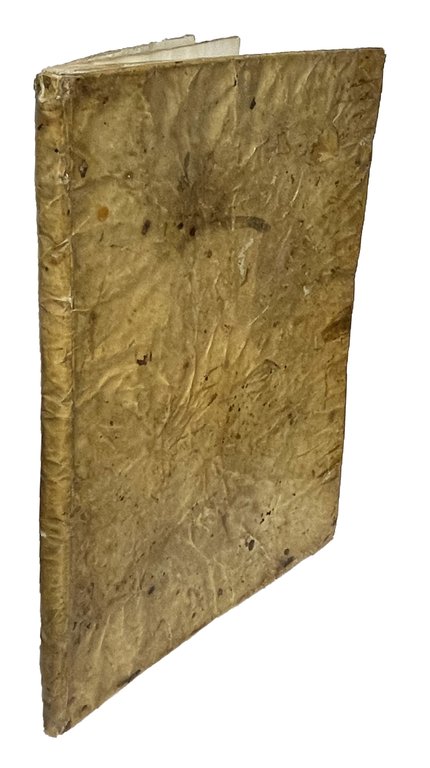




Rare and modern books
FRANCINI, Alessandro (after 1571-1648)
Livre d'architecture contenant plusieurs portiques de différentes inventions sur les cinq ordres de colomnes. Par Alexandre Francine Florentin, ingenieur ordinaire du Roy, dediè a sa Majesté
Paris, chez Melchior Tavernier, graveur & imprimeur du Roy, 1631
4200.00 €
Govi Libreria Antiquaria
(Modena, Italy)
The correct shipping costs are calculated once the shipping address is entered during order creation. One or more delivery methods are available at the Seller's own discretion: Standard, Express, Economy, In-store pick-up.
Bookshop shipping conditions:
For items priced over €300, it is possible to request an instalment plan from Maremagnum. Payment can be made with Carta del Docente, Carta della cultura giovani e del merito, Public Administration.
Delivery time is estimated according to the shipping time of the bookshop and the courier. In case of customs detention, delivery delays may occur. Any customs duties are charged to the recipient.
For more infoPayment methods
- PayPal
- Credit card
- Bank transfer
-
-
Find out how to use
your Carta del Docente -
Find out how to use
your Carta della cultura giovani e del merito
Details
Description
Folio (419x287 mm). [4] leaves (title, descriptive list of plates, author's dedication to Henri IV, address Aux Amateurs d'Architecture) and XXXX engraved plates (platemark, ca. 360×250 mm). Contemporary flexible vellum (ancient repair to back panel, darkened, notes and penwork on the panels, lacking front flyleaf). Manuscript notes on the pastedowns. Marginal stains, stronger at the end of the volume, but overall a good, tall copy.
First edition (a second edition using the same plates was published by Tavernier in 1640 and an English version, illustrated by reversed copies, was published at London by Robert Pricke in 1669) of this series of forty inventions for monumental doorways and entrances in a Baroque style, many of which are conceived for the grottoes of the royal gardens including the one of the Fontainebleau castle, where Francini worked and lived for most of his life. All the plates, but plate I, are signed by Francini as “inventor” and the majority of them (32) is also signed by Melchior Tavernier as engraver. In the present copy plate I, containing the portrait of Francini, is not signed by Abraham Bosse as in most copies, but contains only Tavernier's imprint at the bottom. The unsigned plates, including the first, are believed to have been engraved by Bosse. Of all the orders Alessandro Francini seemed to prefer the massive Doric order as he uses it in nineteen designs, while six designs show the Tuscan column, six the Ionic, five the Corinthian, and three feature the Composite order.
As soon as Tommaso Francini had finished the grottoes of Saint-Germain-en-Laye, some of which were ready by the end of 1599, Henry IV commissioned the Francini brothers (Tommaso, Camillo and Alessandro) to set up the fountains in the gardens of the castle of Fontainebleau, entrusting their maintenance to Alessandro, who was placed under the direct dependence of his elder brother Tommaso. Alessandro was probably born in Florence. His education is unknown, while his life seems to have been spent entirely in the shadow of his brother Tommaso, whom he followed to France at an unspecified date, as his other brother Camillo had already done before him. As the latter is named in the February 1600 letter in which Henry IV granted Tommaso Francini the French nationality, while no mention of Alessandro is found there, it is likely that he joined his two brothers somewhat later. Alessandro is first mentioned on July 20, 1602, when he was witness to the contract preceding Tommaso's marriage: in the text he is referred to as ‘gentilhomme ordinaire du Roi'. The link with Tommaso's family must always have been very close, since on August 14, 1603, Alessandro was godfather at the baptism of Pietro, Tommaso's second natural son. Meanwhile, since April of that year he had obtained the rights already granted to the other two Francini. He could enjoy an annual salary of 600 francs for the maintenance of the waters and fountains of the Chateau of Fontainebleau, and he was put under his brother's direct dependence. With him he probably collaborated on the decoration of the grottoes in the gardens of the royal residence at Saint-Germain-en-Laye. A bird's-eye view of the Chateau of Saint-Germain-en-Laye, engraved by Michel Lasne, with the inscription ‘Alexander Francini florentinus figuravit 1614', shows the design of the garden, articulated in terraces in such a way as to allow the outflow of water, collected upstream before the fountain of Mercury and then channeled downstream, according to a system already adopted at the villa of Pratolino in Tuscany. In 1608 Alexander was paid, as a fountainkeeper, for the maintenance and cleaning of the cisterns, conduits and fountains of the castle of Fontainebleau, the construction of which he had been assisting with his brother. Later the wear and tear on the water conduits forced Alexander, again alongside Tommaso, to undertake numerous restoration works. In 1618

